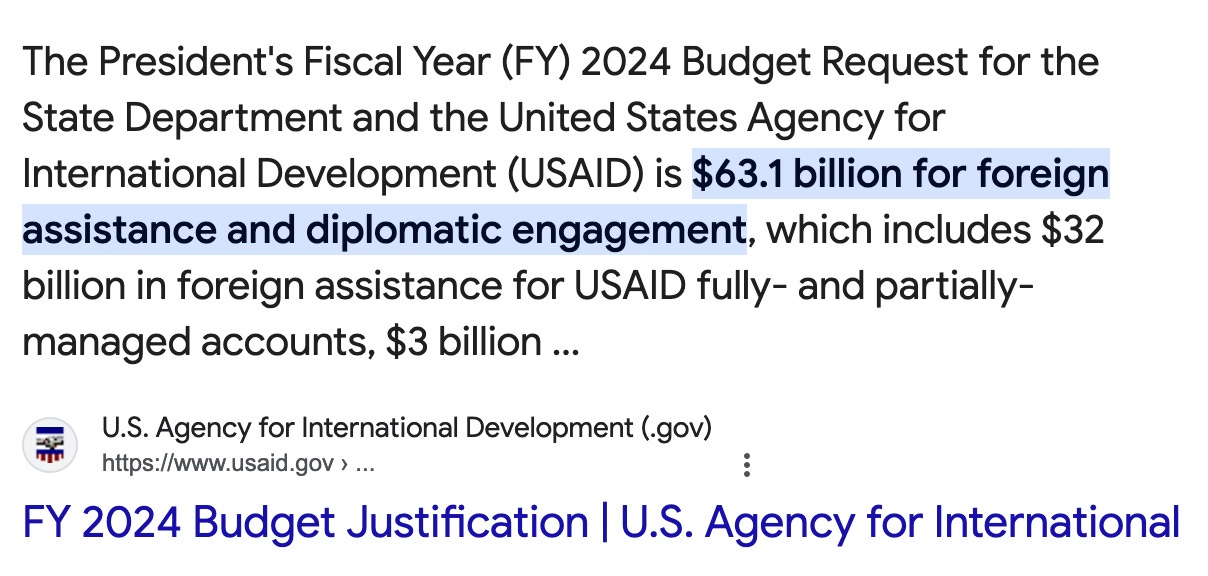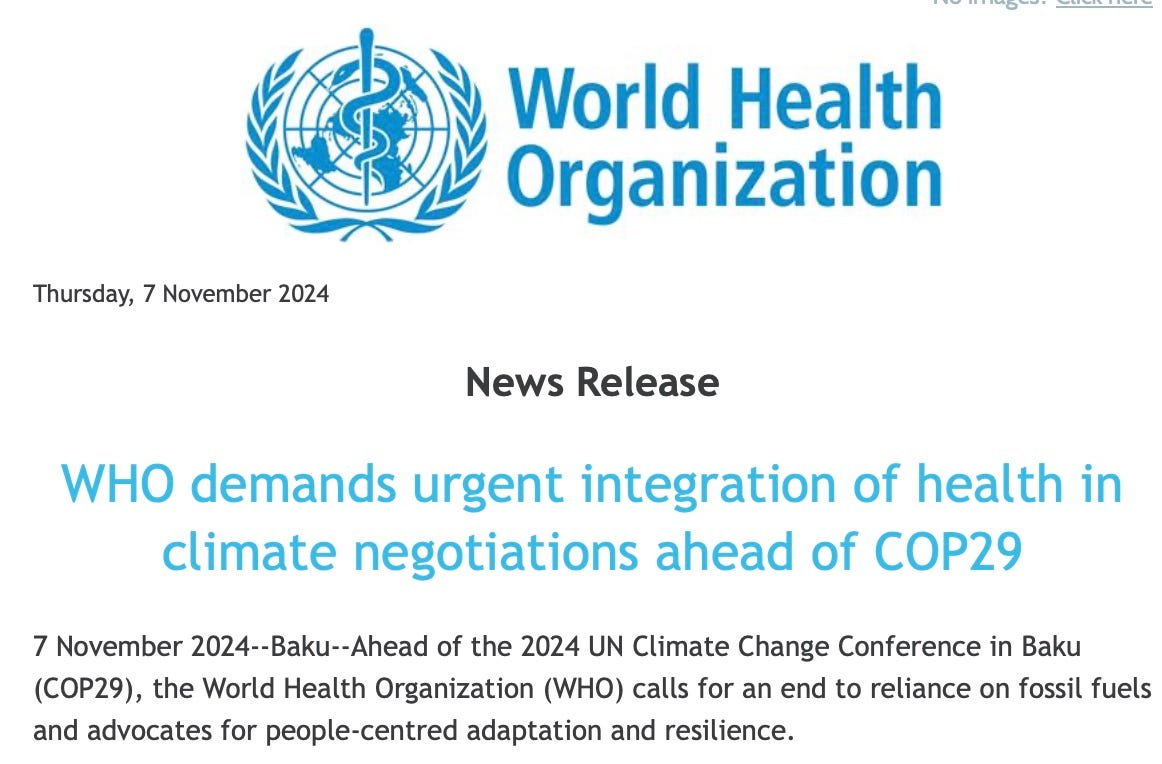The magical fusion of HEALTH with Climate Change: "WHO demands urgent integration of health in climate negotiations" -- to generate at least $1 Trillion/yr for the Green Transition
Will this new climate spin work? Trillions sought--grab Biden's signature now while you can at COP29
I have said before that the WHO could not get sufficient steam behind its existential climate change agenda, so the PR boys advised that Health be made a part of climate change, since everyone still seemed to be concerned about threats to their health.
This started out with Tony Fauci and Peter Daszak telling us that humans were causing climate change, and this was leading to pandemic zoonoses. If we weren’t good boys and girls and stopped using fossil fuels, we would experience more and more pandemics because those bat caves would be getting mighty hot, and the bats would come out for air— while the ever-growing need for farmland meant the people would be moving closer and closer to the bat caves, until something terrible happened. Again and again.
I noticed this in mid 2020 and realized that something smelled fishy about it. (This was before anyone knew Peter Daszak was the EcoHealth Alliance launderer of money to the WIV and at least 30 other international labs, from at least 5 US government agencies.) USAID was Peter’s biggest funder, immediately followed by DOD. Listen to Mike Benz regarding USAID—it is really a deep state slush fund. Watch Samantha Power refuse to answer questions about it when asked by Congress. USAID’s budget of about $32 Billion equals that of the State Department, of which it is an offshoot.
Foreign assistance to create potential pandemic pathogens. The citizens pay, thinking they are being virtuous, while under the guise of humanitarian relief we are actually paying for globalists to consolidate their control over us. As Catherine Austin Fitts says, we are paying for our own enslavement.
Well, over the past few years I noticed that the WHO’s climate change spin was increasingly about health. And TODAY the WHO laid it out for everyone to see: Health and Climate have been fused.
Launching the COP29 special report on climate and health and a technical guidance on Healthy Nationally Determined Contributions, WHO urges world leaders at COP29 to abandon the siloed approach to addressing climate change and health. It stresses the importance of positioning health at the core of all climate negotiations, strategies, policies and action plans, to save lives and secure healthier futures for present and future generations.
“The climate crisis is a health crisis, which makes prioritizing health and well-being in climate action not only a moral and legal imperative, but a strategic opportunity to unlock transformative health benefits for a more just and equitable future,” said Dr Tedros Adhanom Ghebreyesus, WHO Director-General. “COP29 is a crucial opportunity for global leaders to integrate health considerations into strategies for adapting to and mitigating climate change. WHO is supporting this work with practical guidelines and support for countries.”
Bold health argument for climate action
Developed by WHO in collaboration with over 100 organizations and 300 experts, the COP29 special report on climate change and health identifies critical policies across three integrated dimensions – people, place and planet. The report outlines key actions aiming to protect all people, particularly the estimated 3.6 billion people who live in areas which are most susceptible to climate change.
The report underlines the importance of the governance that integrates health in climate policy-making – and climate in health policy-making – being essential for progress. The report’s top recommendations include:
make human health and well-being the top measure of climate success to catalyse progress and ensure people-centred adaptation and resilience;
end fossil fuel subsidies and reliance by realigning economic and financial systems to protect both people's health and the environment, through investment in clean, sustainable alternatives that reduce pollution-related diseases and cut carbon emissions;
mobilize financing for climate-health initiatives, particularly to strengthen responsive health systems and support the health workforce, creating resilient, climate-proof health systems to protect health and save lives;
invest in proven solutions; just 5 interventions – from heat-health warning systems, to clean household energy, to efficient pricing of fossil fuels – would save almost 2 million lives a year, and bring US$ 4 in benefits for each dollar invested;
build greater focus on the role of cities in health outcomes, through more sustainable urban design, clean energy, resilient housing, and improved sanitation; and
increase protections for and restoration of nature and biodiversity, recognizing the synergistic health benefits of clean air, water and food security.
“Health is the lived experience of climate change,” [What? Who writes this unintelligible gibberish?—Nass] said Dr Maria Neira, Director, Environment, Climate Change and Health, WHO. “By prioritizing health in every aspect of climate action, we can unlock significant benefits for public health, climate resilience, security, and economic stability. Health is the argument we need to catalyze urgent and large-scale action in this critical moment.” [In other words, our funding requests will now threaten poor health if our demands are not met.—Nass]
But here is what this is really about:
https://unclimatesummit.org/unlocking-trillions-for-climate-finance/
As the world grapples with the escalating climate crisis, the need for substantial financial resources to support developing countries in their energy transition has never been more urgent. Current projections indicate that annual international investments in climate action must increase by at least $1 trillion annually by 2030 for developing countries (excluding China) to meet their energy transition needs. While this figure may seem daunting, there is a silver lining: the money is available within the global financial system. The challenge lies in unlocking these funds and channeling them effectively towards climate action.
The key to unleashing this financial potential lies in the hands of governments. By revamping existing systems and implementing additional mechanisms, generating climate finance is not only possible but within reach. This article explores various avenues to mobilize the necessary funds and presents compelling reasons why such investments are crucial for our collective future.
Mobilizing Climate Finance requires Global Effort
Before delving into the specifics of unlocking climate finance, it’s essential to understand why these investments are so critical. By making more and better investments in climate action, we can simultaneously address the climate crisis while creating a wealth of jobs and opportunities. Moreover, the economic benefits of such investments are substantial: for every dollar spent today on climate action, we can save between $4 and $7 in future climate-related costs.
It’s important to note that redistributing wealth to finance a secure future for all will benefit both people and planet. Every country stands to gain from this global effort. However, this financial mobilization must go hand in hand with a multilateral framework for dealing with sovereign debt distress, ensuring that developing nations are not further burdened as they transition to sustainable economies.
Avenues for Unlocking Climate Finance
1. Multilateral Development Banks (MDBs) Reform
The World Bank and other MDBs play a unique role in allocating finance, particularly in developing countries. Their high credit ratings allow them to provide concessional funding to nations that might otherwise struggle to access financial markets due to high risks.
In 2022, an independent review commissioned by the G20 found that MDBs could unlock hundreds of billions of dollars in lending by adopting recommendations from the Capital Adequacy Framework review. While MDBs have already undertaken measures that could help unlock $357 billion over the next decade, there’s potential to release hundreds of billions more through some additional measures.
To achieve financing to scale, MDBs must triple their lending to finance resilience by fully utilizing existing resources. This includes taking on more risk, incorporating callable capital in balance sheets, promoting financial innovation, improving credit rating agency assessments, and increasing access to data and analysis.
2. Special Drawing Rights (SDRs)
The 2021 SDR allocation of $650 billion by the International Monetary Fund (IMF) was the largest in history, providing non-debt-creating crisis relief to many emerging markets and low-income economies. A new allocation of SDRs, as demanded by developing country leaders, could generate hundreds of billions of dollars of additional financing and create an enabling environment for countries to drive climate action.
Furthermore, recycling existing SDRs through MDBs as hybrid capital could leverage up to $80 billion in additional financing, part of which can be directed towards resilience projects in developing countries.
3. Global Taxation
Various innovative models to increase climate and development finance have been proposed in recent years. Some of these proposals, such as taxing the wealth of billionaires, which could generate an additional $250 billion annually, are now backed by G20 countries.
Other potential sources include:
A carbon levy on fossil fuel producers ($720 billion by 2030)
A shipping levy ($80 billion a year)
An air passenger levy ($121 billion a year)
A financial transaction tax (between $169 and $281billionn a year)
Additionally, taxing windfall profits from fossil fuel companies and financial institutions could generate an extra $382 billion for climate finance.
4. Private Finance Mobilization
The private sector, which manages more than $210 trillion in assets, has a crucial role to play in funding the green transition. While its contribution to climate finance has been marginal so far, estimates suggest that a five-fold increase in private sector mobilization could generate $500 to $600 billion for climate action.
Governments and public institutions have a pivotal role in creating the right conditions to mobilize private finance. By unblocking the flow of private savings, [???] we can help finance the green transformation in developing countries.
5.Fossil Fuel Subsidy Reform
Fossil fuel subsidies have reached alarming levels, with a record $7 trillion in 2022, including $1.3 trillion in direct government subsidies. Redirecting these funds can both free up money for climate finance and slow down emissions. Governments and institutions need to urgently scale back these environmentally harmful subsidies, which are diverting much-needed financing from just transition projects.
The Road Ahead, From UNGA to COP29 and Beyond
Unlocking trillions for climate action is not just a possibility; it’s a necessity. By leveraging the financial mechanisms discussed above, we can create a more sustainable and equitable future for all. Here’s what needs to happen:
MDBs must adopt the recommendations of the Capital Adequacy Framework review and significantly increase their lending capacity.
A new issuance of SDRs should be implemented as a fair and rapid way to boost reserves and create fiscal space for climate-vulnerable nations.
Global leaders need to embrace innovative taxation models to generate dedicated, affordable, and accessible finance for climate-positive investments at scale.
The private sector must be incentivized and enabled to play a larger role in climate finance.
Governments must commit to phasing out fossil fuel subsidies and redirecting those funds to climate action.
As we stand at this critical juncture, the choices we make today will shape the world for generations to come. By unlocking these vast financial resources and directing them towards climate action, we have the opportunity to create a more resilient, sustainable, and prosperous world for all. The money is there; now it’s time for decisive action to unleash its potential for the benefit of our planet and its people.







Someone put a pin in their balloon. For God sakes
There is NO climate crisis. Scam. Who is the last organization we need our bill gates marching orders for our own health.
Trump please cut off the who again.
Defund now